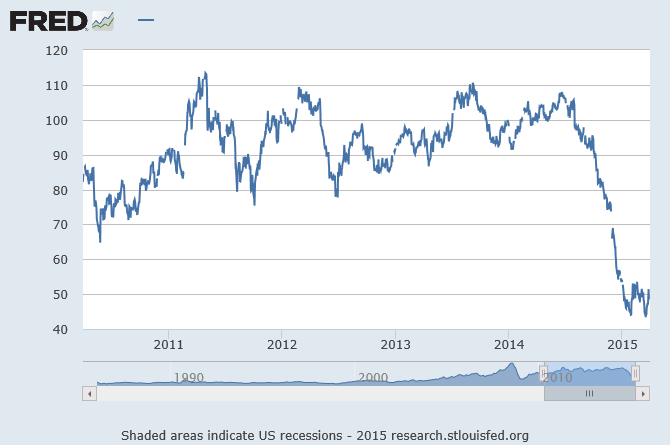|
|






| |

April 2015 SEE Monthly Update -
Regulatory Changes, Earthquakes, and Proppant Companies

Graph of crude oil prices. Vertical axis is $/barrel for West Texas Intermediate at Cushing
Producers and investors have anxiously been watching oil storage levels at Cushing—rising until last week; oil production (Iran's re-entry has been delayed and the first estimated decline in U.S. production, of 100,000 barrels per day (BPD) out of 9.3 million BPD, appears to be occurring); and oil demand, which has registered a slight upturn. The oil industry continues to adjust to the fifty percent cut in prices and revenues since last November.
Additional costs are coming into play. In North Dakota, oil producers are required to flare less gas. According to the Energy Information Administration, “The first target of 26% flared is set for fourth-quarter 2014, with continued decreases in flaring reaching 10% by 2020.” As of April 1, North Dakota producers are also expected to heat-treat crude oil to 110 degrees at 50 pounds per square inch (psi) pressure and separate the light hydrocarbons from crude. The new oil vapor pressure regulation in North Dakota is a Reid Vapor Pressure (RVP) of 13.7 psi. For context, the New York Mercantile Exchange oil specification is an RVP of less than 9.5 psi.
Railroads and shippers are also required to replace the existing fleet of tank cars with stronger, more durable ones.
In Oklahoma, discussion of reducing the use of deep wastewater disposal wells is (finally) underway. Wastewater from oil drilling is both flowback water (recovery of water used for hydraulic fracturing) and produced water—formation water produced along with oil, condensate, and natural gas. Indeed, one Oklahoma operator has called well drilling in Oklahoma's Mississippi Lime formation “rock washing” because such a large part of the produced liquid is water. This wastewater has a very high level of dissolved salts and solids. Although permitting of deep wastewater disposal wells is limited or not allowed in states such as Arkansas, Colorado, Ohio, and Texas due to the increase in earthquakes associated with the wells, Oklahoma has been slower to require permits or alternate processes, despite the hundreds of earthquakes that have occurred there, at magnitudes of up to 5.7.
According to a Congressional Research Service report dated December 22, 2014, “The relationship between earthquake activity and the timing of injection, the amount and rate of fluid injected, and other factors are still uncertain and are current research topics. Despite increasing evidence linking some deep-well disposal activities with human-induced earthquakes, only a small fraction of the more than 30,000 U.S. wastewater disposal wells appears to be associated with damaging earthquakes... EPA authorized a national UIC technical work group to develop recommendations to address the risk of Class II disposal-induced seismicity. EPA plans to issue a document outlining technical recommendations and best practices in early 2015. At the state level, several states have increased oversight of Class II wells in response to induced seismicity concerns.”
Because oilfield services and suppliers have been forced to streamline operations, each factor has been examined, with crews reduced and equipment sidelined as the rig count drops by half. Nonetheless, frack sand companies bear a closer look because of the opportunities for improved production they bring to horizontal shale well drilling.
For more on this topic log in now or, if you are not already a subscriber, subscribe now.
Copyright 2015, Starks Energy Economics, LLC. This information is confidential and is intended only for the individual named. This information may not be disclosed, copied or disseminated, in whole or in part, without the prior written permission of Starks Energy Economics, LLC. This communication is based on information which Starks Energy Economics, LLC believes is reliable. However, Starks Energy Economics, LLC does not represent or warrant its accuracy. This communication should not be considered as an offer or solicitation to buy or sell any securities.
I, Laura Starks, do hereby certify that, to the best of my knowledge, the views and opinions in this research report accurately reflect my personal views about the companies and their securities as of the date of this report. These viewpoints and opinions may be subject to change without notice and Starks Energy Economics, LLC will not be responsible for any consequences associated with reliance on any statement or opinion contained in this communication. No Starks Energy Economics, LLC consultant or analyst has nor will receive direct or indirect compensation in return for expressing specific recommendations or viewpoints in this report.


sitemap | home | contact us | bio | links | events
|
|
|



































